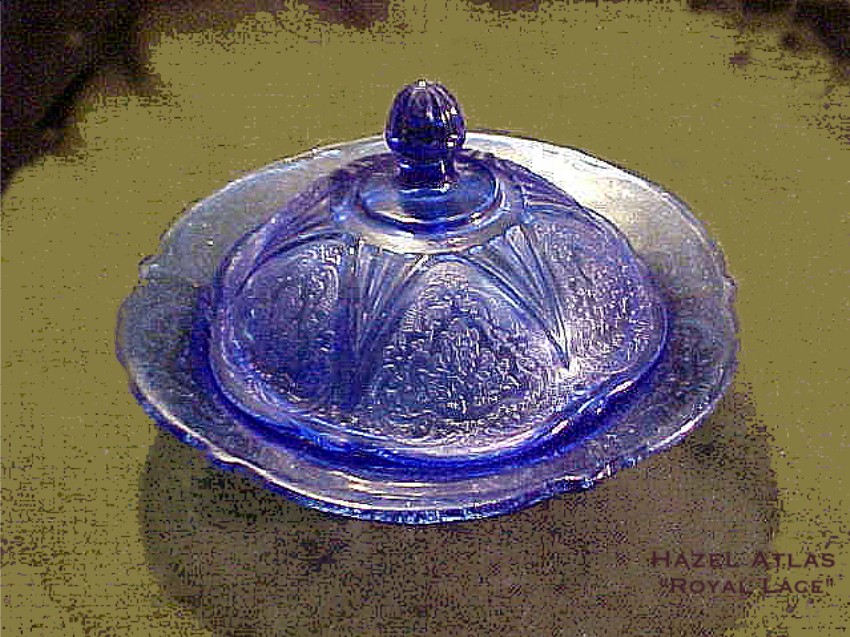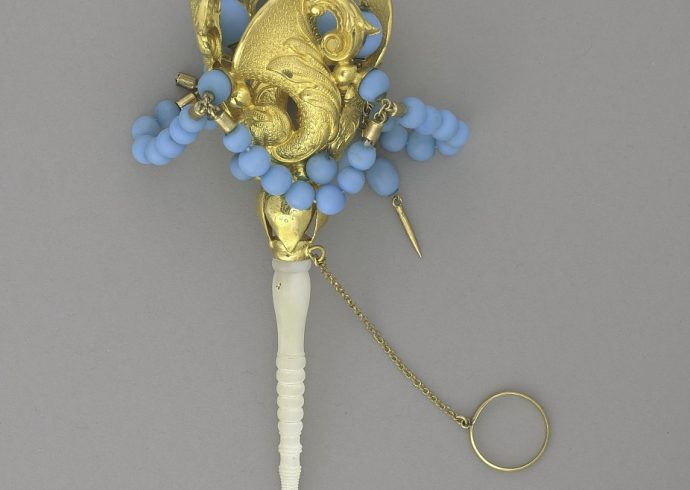
Depression Glassware: The Hazel Atlas Glass Company
The Hazel Atlas Glass Company was founded in 1902 in Wheeling, West Virginia. The company was a merger of the Hazel Glass Company, The National Glass Company, The Atlas Glass Company, and Wheeling Metal Plant. Hazel Atlas had factories located in Oklahoma, California, West Virginia, Alabama, and Ohio during the early to mid-1900’s.
Like many other glass companies in the 1930’s, Hazel Atlas also produced Depression glass in pressed molds as well as etched patterns. Along with the standard pink, yellow, and green glass, Hazel Atlas also produced burgundy and cobalt blue glass. In 1936 the company received a patent for a glass color known as platonite, a shade of white with a bluish hue. Milk glass was also produced in abundance, from vases and bottles to commercial cold-cream jars. In addition to Depression glass, Hazel Atlas also manufactured fruit jars of numerous sizes for commercial use, in addition to Mason jars, ink bottles, glue bottles, jelly glasses, pickles jars, olive jars, and meat jars, leading the company to be the third largest producer of commercial glass intended for use by cosmetic manufacturers and food manufacturers. In 1923, Hazel Atlas employed 5,000 people in its plants; when the plant in Blackwell, Oklahoma, opened that year, more than 200 new employees were added to the payroll. It seemed fitting to have a plant in Blackwell, since the founders of Hazel Glass Company had roots in that city: brothers Robert, David, and Alex Ballentine, along with John W. Carnahan, back in 1886 started Hazel Glass Company in Wellsburg, West Virginia. The Hazel Atlas factory in Pomona, California opened in 1947. Occupying 26-acres, several buildings totaled 300,000 square feet. The furnace was large enough to hold up to 195 tons of molten glass at a single time, producing 140 tons of glass a day.
Hazel Atlas also produced a number of blue glassware items with a decal image of Shirley Temple on them. General Mills offered these pieces as premiums. The pieces produced by Hazel Atlas bear a hallmark of an H directly above an A on the back. In 1957, fourteen Hazel Atlas plants were purchased by The Continental Can Company. By 1964, these plants were further divided with eight plants sold off to Brockway Glass Company, three other plants were shut down, one plant was sold to a Continental division, and one plant sold to Anchor Hocking Glass. Continental kept only one plant open in Clarksburg, West Virginia.
Some of the patterns produced by Hazel Atlas:
Cloverleaf. Produced in light green, pink, yellow, black, and crystal, the design was a three-leafed clover and leaf pattern made as a mold-etching. This pattern was available in plates, cups, bowls, sugar and creamer sets, tumblers, salt and pepper sets, and a candy dish. The only pieces that came in black were an eight-inch plate, cup, saucer, sugar and creamer, salt and pepper set, and sherbet dish. Cloverleaf was produced from 1931 to 1935.
Old Florentine. Produced in light green, yellow, pink, and crystal, some pieces in dark blue, the design was a mold etched pattern of Florentine scrollwork and small poppy flowers. The dishes are hexagonal in shape and have serrated edges. The set with this pattern included: plates, cups, saucers, bowls, platters, sugar and creamers, pitchers, footed tumblers, butter dishes, salt and pepper sets. Old Florentine was produced from 1932 to 1934.
Florentine. Produced in pink, light green, yellow, crystal in a mold etched pattern similar to Old Florentine but in a wider design with larger poppy flowers. Florentine was available as a complete tableware set and vases, coasters, candle holders, candy jars, and ash trays. The edges of Florentine dishes and bowls were round. Florentine was produced from 1934 to 1936.
Moderntone. Produced in cobalt blue and burgundy, this set was a pressed pattern with several ribs forming the design. The burgundy was closer to a shade of purple rather than red. The Moderntone set included: plates, cups, bowls, platters, sugar and creamer sets, salt and pepper sets, and sherbet dishes. Moderntone was produced from 1934 to 1937.
New Century. Produced in light green and bears no pattern, the set is pressed glass, and consists of plates, cups, saucers, bowls, sugar and creamer, sherbet dishes, candle holder, and cocktail glass. New Century was produced from 1930 to 1932.
Ribbon. Produced in green, this pressed glass pattern consists of ribbons closely set together. Plates, cups, bowls, saucers, sugar and creamer, tumblers, sherbet dishes, and candy dishes were made with this pattern. Ribbon was produced from 1930 to 1931.
Royal Lace. Produced in cobalt blue, pink, green, burgundy, and crystal from a mold-etched pattern of lace and flowers, Royal Lace was available as a complete tableware set. In 1937, some pieces with the Royal Lace pattern were produced in amethyst. Royal Lace was produced from 1934 to 1941.
Starlight. Produced in pink and crystal with a pressed pattern that resembles a lacy weave, Starlight was available in plates, cups, saucers, bowls, sugar and creamer sets, salt and pepper sets. Starlight was produced in 1938.
Image Credit: Hazel Atlas: Vintage glass candy bowl with lid made by Hazel Atlas, “Royal Lace”. April 2016. M. Neck, Houston TX, Flickr. Used with permission.


